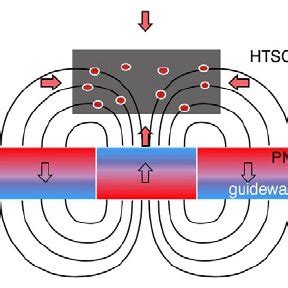
A video showcasing a magnet levitating within a superconductive chamber has sparked intense debate online, prompting some to suggest a potential paradigm shift in our understanding of physics. While the phenomenon itself is rooted in established principles of superconductivity, the visual demonstration has ignited discussions about its potential implications and whether it could lead to revolutionary technological advancements.
The video, widely circulated on social media platforms, depicts a small, seemingly ordinary magnet suspended in mid-air above what appears to be a dark, circular surface. This surface is a high-temperature superconductor, a material that, when cooled below a critical temperature, exhibits zero electrical resistance and expels magnetic fields. This expulsion, known as the Meissner effect, is the key to the levitation.
“It’s not ‘breaking’ physics, but demonstrating a well-understood principle of superconductivity,” explains Dr. Emily Carter, a materials science professor at the University of California, Berkeley, who was not involved in the video’s creation. “The Meissner effect is a fundamental property of superconductors, and this video is a visual representation of that.”
The phenomenon relies on the interplay between the superconductor’s ability to conduct electricity without resistance and its response to external magnetic fields. When a magnet is brought near a cooled superconductor, the superconductor generates surface currents that create a magnetic field mirroring that of the magnet. This mirroring effect results in a repulsive force, causing the magnet to levitate.
While not violating any known laws of physics, the demonstration highlights the remarkable properties of superconductors and their potential for transformative applications. From high-speed trains to lossless power transmission, superconductors hold the promise of revolutionizing various industries. However, significant challenges remain in terms of material stability, cost-effectiveness, and maintaining the extremely low temperatures required for superconductivity.
The renewed interest in superconductivity, spurred by viral videos like this, underscores the public’s fascination with cutting-edge science and its potential to reshape the future. Further research and development are crucial to unlocking the full potential of these materials and bringing their applications into the mainstream.
Delving Deeper: The Science Behind Superconductivity
Superconductivity, discovered in 1911 by Heike Kamerlingh Onnes, is a quantum mechanical phenomenon characterized by the complete absence of electrical resistance and the expulsion of magnetic fields (the Meissner effect) from the interior of the material. It occurs in certain materials when cooled below a specific critical temperature.
Conventional superconductors, described by the Bardeen-Cooper-Schrieffer (BCS) theory, involve the formation of Cooper pairs – pairs of electrons that are weakly bound together near the Fermi level. These Cooper pairs can move through the crystal lattice without scattering, leading to zero electrical resistance.
High-temperature superconductors (HTS), discovered in 1986, are a class of materials, typically complex copper oxides, that exhibit superconductivity at significantly higher temperatures than conventional superconductors. Although the exact mechanism behind HTS is still not fully understood, it is believed to involve unconventional pairing mechanisms beyond the BCS theory.
The Meissner effect, named after Walther Meissner, is the expulsion of a magnetic field from a superconductor during its transition to the superconducting state. This phenomenon is distinct from simply having zero resistance; a perfect conductor would only prevent changes in magnetic flux, whereas a superconductor actively expels any existing magnetic field.
The levitation seen in the video is a direct consequence of the Meissner effect. The superconductor expels the magnetic field of the magnet, creating an opposing force that counteracts gravity, causing the magnet to float. The stability of the levitation is due to the “flux pinning” effect, where magnetic flux lines become trapped within the superconductor, preventing the magnet from drifting.
The Promise and Challenges of Superconductive Technology
The potential applications of superconductivity are vast and transformative, spanning numerous industries and impacting various aspects of modern life. However, realizing these applications requires overcoming significant technological and economic challenges.
Potential Applications:
-
High-Speed Transportation: Superconducting magnets can be used to levitate trains, eliminating friction and enabling extremely high speeds. Maglev (magnetic levitation) trains are already in operation in some countries, demonstrating the feasibility of this technology.
-
Lossless Power Transmission: Superconducting cables can transmit electricity with virtually no energy loss, significantly improving the efficiency of power grids and reducing greenhouse gas emissions.
-
Advanced Medical Imaging: Superconducting magnets are used in Magnetic Resonance Imaging (MRI) machines to generate strong and stable magnetic fields, enabling high-resolution medical imaging.
-
High-Energy Physics: Superconducting magnets are essential components of particle accelerators, such as the Large Hadron Collider (LHC) at CERN, which are used to study the fundamental constituents of matter.
-
Quantum Computing: Superconducting circuits are being explored as a promising platform for building quantum computers, which have the potential to solve complex problems that are intractable for classical computers.
-
Fusion Energy: Superconducting magnets are crucial for containing the plasma in fusion reactors, which aim to harness the energy of nuclear fusion as a clean and sustainable energy source.
-
Sensitive Magnetic Field Sensors: Superconducting Quantum Interference Devices (SQUIDs) are extremely sensitive magnetometers used in various applications, including medical diagnostics, geophysical exploration, and non-destructive testing.
Challenges:
-
Low Critical Temperatures: Most superconductors require extremely low temperatures (typically near absolute zero) to operate, necessitating expensive and energy-intensive cooling systems.
-
Material Brittleness: Many superconducting materials are brittle and difficult to fabricate into wires or other useful forms.
-
High Manufacturing Costs: The production of superconducting materials and devices can be expensive, limiting their widespread adoption.
-
Flux Creep: In some superconductors, magnetic flux lines can slowly move, leading to energy dissipation and instability.
-
Quench Protection: Superconducting magnets can experience a “quench,” a sudden loss of superconductivity that can generate intense heat and damage the magnet. Robust quench protection systems are needed to prevent such events.
-
Understanding High-Temperature Superconductivity: The underlying mechanism of high-temperature superconductivity is still not fully understood, hindering the development of new and improved materials.
The Video’s Impact and the Importance of Scientific Literacy
The viral video of the levitating magnet has undoubtedly captured the public’s imagination, demonstrating the captivating nature of scientific phenomena. However, it also highlights the importance of scientific literacy and the need for accurate information to avoid misconceptions and overblown claims.
While the video demonstrates a real and well-established scientific principle, it is crucial to understand that it does not represent a violation of the laws of physics or a revolutionary breakthrough that will immediately transform the world. The technology is still limited by the need for very cold temperatures to maintain the superconductivity. Sensationalizing such demonstrations can lead to unrealistic expectations and undermine public trust in science.
It is important to distinguish between scientific demonstrations that illustrate fundamental principles and technological advancements that have practical applications. While the levitating magnet is an excellent visual representation of the Meissner effect, it is not a prototype for a levitating car or a limitless source of energy.
Media outlets and science communicators have a responsibility to provide accurate and contextualized information about scientific discoveries and technological advancements. This includes explaining the underlying principles, highlighting the limitations, and avoiding sensationalized claims. By promoting scientific literacy, we can empower the public to critically evaluate scientific information and make informed decisions about science-related issues.
The public’s fascination with the levitating magnet should be seen as an opportunity to foster greater interest in science and technology. By providing accessible and engaging explanations of scientific concepts, we can inspire the next generation of scientists and engineers and promote a more scientifically literate society.
The Future of Superconductivity: Research and Development
Despite the challenges, research and development in superconductivity continue to advance, driven by the potential for transformative applications and the ongoing quest to understand the underlying physics of these fascinating materials.
Scientists are exploring new materials with higher critical temperatures, improved mechanical properties, and lower manufacturing costs. They are also developing new techniques for fabricating superconducting wires and devices, and for protecting superconducting magnets from quenches.
One promising area of research is the development of room-temperature superconductors, materials that would exhibit superconductivity at or near room temperature. Such materials would revolutionize various industries, eliminating the need for expensive cooling systems and making superconducting technology more accessible and practical. While room-temperature superconductivity remains a distant goal, recent theoretical and experimental advances have provided glimpses of hope.
Another important area of research is the development of new applications for existing superconducting materials and devices. For example, scientists are exploring the use of superconducting wires to build more efficient electric motors and generators, and the use of SQUIDs to detect brain activity and diagnose neurological disorders.
Governments, universities, and private companies are investing heavily in superconductivity research and development, recognizing its potential to address some of the world’s most pressing challenges, including energy efficiency, healthcare, and transportation. With continued investment and innovation, superconductivity promises to play an increasingly important role in shaping the future.
The demonstration of a levitating magnet, while not “breaking physics,” serves as a powerful reminder of the remarkable properties of superconductors and their potential to transform our world. By fostering scientific literacy and supporting continued research and development, we can unlock the full potential of these materials and bring their applications into the mainstream.
FAQ: Frequently Asked Questions About Superconductivity and the Levitating Magnet
Q1: Is the levitating magnet breaking the laws of physics?
A: No, the levitating magnet is not breaking any laws of physics. It is a demonstration of the Meissner effect, a well-understood phenomenon in superconductivity. The Meissner effect is the expulsion of a magnetic field from a superconductor during its transition to the superconducting state. This expulsion creates a repulsive force that counteracts gravity, causing the magnet to levitate. The principles are already established and used in technology such as Maglev trains.
Q2: What is a superconductor, and how does it work?
A: A superconductor is a material that exhibits two key properties below a certain critical temperature: zero electrical resistance and the expulsion of magnetic fields (the Meissner effect). In conventional superconductors, this occurs due to the formation of Cooper pairs, pairs of electrons that can move through the material without scattering. In high-temperature superconductors, the mechanism is more complex and not fully understood.
Q3: What are the potential applications of superconductivity?
A: Superconductivity has a wide range of potential applications, including:
- High-speed transportation (Maglev trains)
- Lossless power transmission
- Advanced medical imaging (MRI)
- High-energy physics (particle accelerators)
- Quantum computing
- Fusion energy
- Sensitive magnetic field sensors (SQUIDs)
Q4: What are the main challenges in developing and using superconductors?
A: The main challenges include:
- Low critical temperatures: Most superconductors require extremely low temperatures to operate, necessitating expensive cooling systems.
- Material brittleness: Many superconducting materials are brittle and difficult to fabricate.
- High manufacturing costs: The production of superconducting materials and devices can be expensive.
- Flux creep: Magnetic flux lines can slowly move, leading to energy dissipation.
- Quench protection: Superconducting magnets can experience a sudden loss of superconductivity, requiring robust protection systems.
Q5: Is room-temperature superconductivity possible, and what would its impact be?
A: Room-temperature superconductivity, the ability of a material to exhibit superconductivity at or near room temperature, is a major goal of research. If achieved, it would revolutionize various industries by eliminating the need for expensive cooling systems. This would make superconducting technology more accessible and practical for a wide range of applications, from power transmission to medical imaging to transportation. It would impact energy efficiency in ways that are hard to fully imagine.
The video showcasing the levitating magnet brings to light the possibilities while simultaneously highlighting the current limitations. Continued research and development are essential to overcome these limitations and unlock the full potential of superconductivity.









